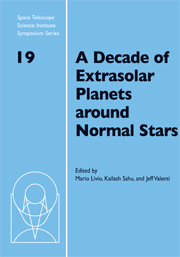 A Decade of Extrasolar Planets around Normal Stars
A Decade of Extrasolar Planets around Normal Stars Published online by Cambridge University Press: 22 October 2009
Human beings have long thought that planetary systems similar to our own should exist around stars other than the Sun. However, the astronomical search for planets outside our Solar System has had a dismal history of decades of discoveries that were announced, but could not be confirmed. All that changed in 1995, when we entered the era of the discovery of extrasolar planetary systems orbiting main-sequence stars. To date, well over 130 planets have been found outside our Solar System, ranging from the fairly familiar to the weirdly unexpected. Nearly all of the new planets discovered to date appear to be gas giant planets similar to our Jupiter and Saturn, though with very different orbits about their host stars. In the last year, three planets with much lower masses have been found, similar to those of Uranus and Neptune, but it is not yet clear if they are also ice giant planets, or perhaps rock giant planets, i.e., super-Earths. The long-term goal is to discover and characterize nearby Earth-like, habitable planets. A visionary array of space-based telescopes has been planned that will carry out this incredible search over the next several decades.
To save this book to your Kindle, first ensure [email protected] is added to your Approved Personal Document E-mail List under your Personal Document Settings on the Manage Your Content and Devices page of your Amazon account. Then enter the ‘name’ part of your Kindle email address below. Find out more about saving to your Kindle.
Note you can select to save to either the @free.kindle.com or @kindle.com variations. ‘@free.kindle.com’ emails are free but can only be saved to your device when it is connected to wi-fi. ‘@kindle.com’ emails can be delivered even when you are not connected to wi-fi, but note that service fees apply.
Find out more about the Kindle Personal Document Service.
To save content items to your account, please confirm that you agree to abide by our usage policies. If this is the first time you use this feature, you will be asked to authorise Cambridge Core to connect with your account. Find out more about saving content to Dropbox.
To save content items to your account, please confirm that you agree to abide by our usage policies. If this is the first time you use this feature, you will be asked to authorise Cambridge Core to connect with your account. Find out more about saving content to Google Drive.